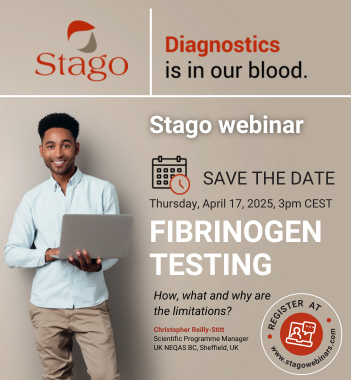How is APS diagnosed?
Diagnosis of APS is based on clinical and laboratory tests and requires at least one clinical criterion in conjunction with one laboratory criterion (Table I).
According to the guidelines of the ISTH Scientific and Standardization Committee (SSC), lupus anticoagulant testing should be performed only in patients at significant risk for APS or presenting unexplained lengthening of activated cephalin time (APTT).
Laboratory diagnosis is complex due to the lack of changes in laboratory parameters pathognomonic for APS. Laboratory diagnosis is thus based on a battery of tests comprising coagulation tests and ELISA.
Coagulation tests
Coagulation tests are performed to demonstrate the presence of lupus anticoagulant able to prolong the time of phospholipid-based coagulation tests.
The presence of lupus anticoagulant is highly specific for APS and there is a strong association between the latter and thrombotic events or foetal loss.
However, numbers of false positives and false negatives are fairly high.
Many factors can affect the lack of sensitivity and specificity of these tests, including pre-analytical, analytical and post-analytical variables.
Diagnostic criteria for circulating lupus anticoagulant
Four such criteria exist and are summarised below.
| 1. Prolongation of phospholipid-dependent coagulation test times |
| 2. Demonstration of inhibition in a mixed patient/normal plasma test |
| 3. Demonstration that prolonged coagulation time is phospholipid-dependent: shortening or correction of initially prolonged coagulation time by addition of excess phospholipid (confirmation test) |
| 4. Exclusion of specific inhibitors directed against coagulation factors (e.g. anti-factor VIII antibodies) |
Pre-analytical variables in screening for circulating lupus anticoagulant
The pre-analytical stage is crucial for the diagnosis of APS.
The presence of residual platelets in plasma can affect coagulation tests that depend upon platelet-derived phospholipids; such phospholipids can neutralise antiphospholipid antibodies present in the sample and produce false negatives. It is therefore recommended that double centrifugation be performed comprising initial centrifugation at 2 000g for 15 minutes at ambient temperature, followed by a second centrifugation at over 2 500g for 10 minutes in order to obtain plasma containing fewer than 10 000 platelets/µL.
Choice of tests
Many phospholipid-dependent tests have been proposed.
Because of varying sensitivity between tests as well as the lack of standardisation in certain tests, the International Society on Thrombosis and Hemostasis (ISTH) has issued guidelines concerning the choice of tests to be used.
Two separate test systems using different principles should be used.
Diluted Russell viper venom time (DRVVT) should be used in all cases. This test is considered specific and robust for the detection of lupus anticoagulants.
The second test to be performed is APTT using silica as the activator on account of its sensitivity. Use of kaolin or ellagic acid as the activator is not recommended, nor is the use of dilute thromboplastin time, of tests based on ecarine or textarine times, or of kaolin clotting time.
Mixing study
The pooled plasma used should be prepared in accordance with the usual methods. Double centrifugation is required in order to obtain plasma containing fewer than 10 000 platelets/µL and having an activity close to 100% for all factors. Commercial pooled plasma, either lyophilised or frozen, may be utilised provided it meets the requisite conditions and has been validated for this purpose.
The mixing test must involve a ratio of 1:1 between test plasma and pooled normal plasma without pre-incubation.
Thrombin time testing prior to the mixing study could demonstrate the presence in the sample of heparin or other inhibitors. However, certain reagents, in particular those used in DRVVT tests, contain an inhibitor of heparin, allowing the test to be performed in samples containing up to 0.8 IU of anti-Xa/mL.
Confirmation tests
These involve evaluation of correction of coagulation time for the plasma sample in the presence of excess phospholipid. Bilayer phospholipids or hexagonal-phase phospholipids should be used. Conversely, use of frozen-thawed platelets is not recommended due to inter-batch variation.
Exclusion of specific inhibitors directed against coagulation factors
Screening for a specific inhibitor directed against a given coagulation factor (primarily factor VIII or factor IX) is essential, since the presence of such inhibitors may expose patients to high and potentially life-threatening hemorrhagic risk requiring immediate management by specialized teams. This test involves assay of the factor in question and, where necessary, specific screening for and assay of the inhibitor.
ELISA tests
Screening for anti-cardiolipin and anti-ß2-GPI antibodies is indicated in the classification of APS (Table I). Although screening for IgG and IgM antibodies is required in both cases, the value of screening for IgM antibodies is disputed due to their apparently poor correlation with thrombotic signs. Furthermore, allowance must be made for the possible presence of cryoglobulin or rheumatoid factor when interpreting the results of testing for IgM antibodies.
Screening for anti-?2-GPI antibodies is especially important in patients with negative lupus anticoagulant screening results despite strong suspicion of APS. Testing for anti-?2-GPI antibodies appears more specific than testing for anticardiolipin antibodies in the diagnosis of APS. Screening for anti-?2-GPI antibodies may in fact be the only positive test for 3 to 10% of patients presenting APS. Despite the lack of test standardisation, testing for anti-?2-GPI antibodies appears more reproducible than testing for anticardiolipin antibodies.
Other tests
Thrombin generation and antiphospholipid antibodies
Studies have demonstrated inhibition of thrombin generation in patients presenting APS, particularly where anti-?2-GPI antibodies are present. In addition, inhibition of thrombin generation is correlated with the existence of previous clinical signs.

